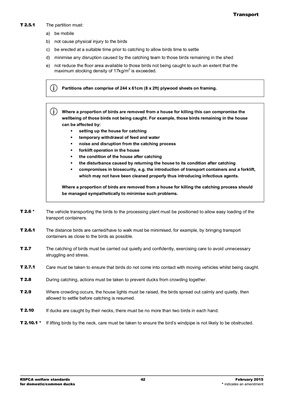
Transport
RSPCA welfare standards
for domestic/common ducks
42 February 2015
* indicates an amendment
T 2.5.1 The partition must:
a) be mobile
b) not cause physical injury to the birds
c) be erected at a suitable time prior to catching to allow birds time to settle
d) minimise any disruption caused by the catching team to those birds remaining in the shed
e) not reduce the floor area available to those birds not being caught to such an extent that the
maximum stocking density of 17kg/m2 is exceeded.
Partitions often comprise of 244 x 61cm (8 x 2ft) plywood sheets on framing.
Where a proportion of birds are removed from a house for killing this can compromise the
wellbeing of those birds not being caught. For example, those birds remaining in the house
can be affected by:
setting up the house for catching
temporary withdrawal of feed and water
noise and disruption from the catching process
forklift operation in the house
the condition of the house after catching
the disturbance caused by returning the house to its condition after catching
compromises in biosecurity, e.g. the introduction of transport containers and a forklift,
which may not have been cleaned properly thus introducing infectious agents.
Where a proportion of birds are removed from a house for killing the catching process should
be managed sympathetically to minimise such problems.
T 2.6 * The vehicle transporting the birds to the processing plant must be positioned to allow easy loading of the
transport containers.
T 2.6.1 The distance birds are carried/have to walk must be minimised, for example, by bringing transport
containers as close to the birds as possible.
T 2.7 The catching of birds must be carried out quietly and confidently, exercising care to avoid unnecessary
struggling and stress.
T 2.7.1 Care must be taken to ensure that birds do not come into contact with moving vehicles whilst being caught.
T 2.8 During catching, actions must be taken to prevent ducks from crowding together.
T 2.9 Where crowding occurs, the house lights must be raised, the birds spread out calmly and quietly, then
allowed to settle before catching is resumed.
T 2.10 If ducks are caught by their necks, there must be no more than two birds in each hand.
T 2.10.1 * If lifting birds by the neck, care must be taken to ensure the bird's windpipe is not likely to be obstructed.